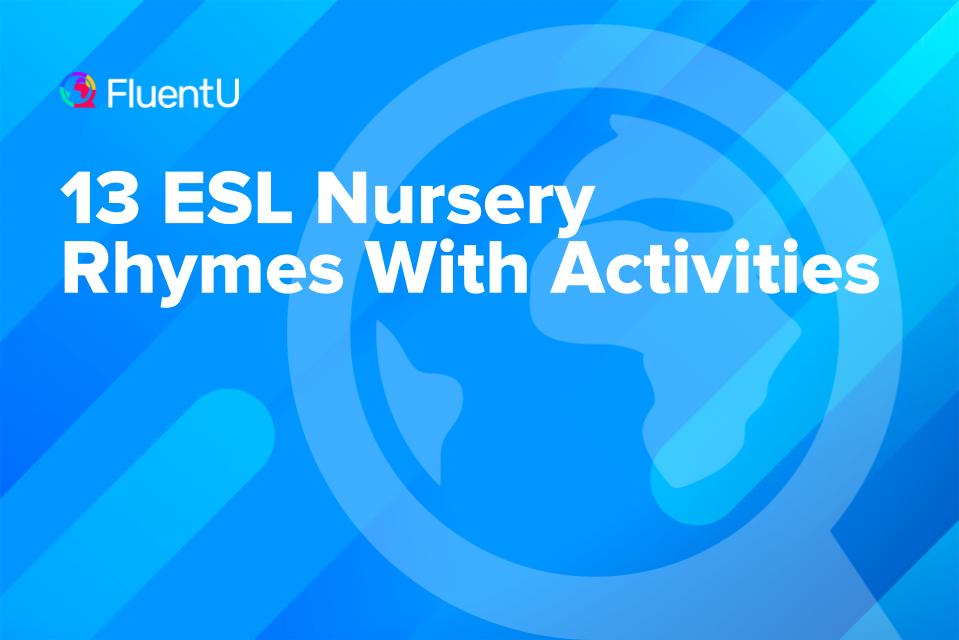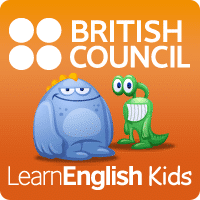Contents
- 13 ESL Nursery Rhymes and Activities
- 1. “One, Two, Buckle My Shoe”
- 2. “Old MacDonald Had a Farm”
- 3. “Georgie Porgie”
- 4. “Pussycat Pussycat”
- 5. “Rain, Rain Go Away”
- 6. “Mary Had a Little Lamb”
- 7. “Hickory Dickory Dock”
- 8. “Hey, Diddle, Diddle”
- 9. “Twinkle, Twinkle, Little Star”
- 10. “To Market, To Market”
- 11. “Star Light, Star Bright”
- 12. “Itsy-bitsy Spider”
- 13. “Row, Row, Row Your Boat”
- Bonus: Peter Piper Picked a Peck of Pickled Peppers
- Ideas to Use Nursery Rhymes in the ESL Classroom
13 ESL Nursery Rhymes With Activities

Nursery rhymes are catchy and easy to memorize, so it’s no surprise we carry them with us our whole lives.
That’s also what makes them ideal teaching tools for your ESL classroom. Younger students will enjoy the songs and rhymes, while older students will appreciate the themes hidden below the surface.
Better yet, the right nursery rhyme can target specific English teaching goals, from counting to past tense verbs.
This post will show you how to teach with them, with 13 classic ESL nursery rhymes you probably remember from your own childhood.
Download: This blog post is available as a convenient and portable PDF that you can take anywhere. Click here to get a copy. (Download)
13 ESL Nursery Rhymes and Activities
Here are some nursery rhymes that are especially beneficial for ESL students. We’ve also included specific ideas for you to introduce and teach each rhyme in your classroom.
You can extend these activities into lessons for older students by including some of the nursery rhyme’s backstory. For example, who created the nursery rhyme? How old is it? Most of the following nursery rhymes have interesting origin stories that you can learn more about with a simple internet search.
1. “One, Two, Buckle My Shoe”
Great for teaching: numbers up to 20
This nursery rhyme is a great way to practice numbers and counting. It also includes some very useful verbs and verb phrases such as “three four shut the door” and “five six pick up sticks.”
As the teacher, feel free to change some of the phrases to include more appropriate verb phrases based on your teaching goals.
2. “Old MacDonald Had a Farm”
Great for teaching: animal names
What a fun way to practice the names of animals! Students can get creative with this nursery rhyme.
As a class, recite the poem. For each verse, include a different animal. Each student should have a turn to contribute an animal name. Don’t limit them to farm animals. Perhaps Old MacDonald also has an alligator, koala and zebra.
Your class will also have a great time coming up with animal noises for each one, and perhaps comparing how different animal sounds are portrayed in their native language vs. in English.
3. “Georgie Porgie”
Great for teaching: general vocabulary
This is a nice nursery rhyme to practice common verbs such as “to kiss” and “to cry.” Try incorporating TPR movements. Since this is a short nursery rhyme, you may also ask students to simply recite the poem.
4. “Pussycat Pussycat”
Great for teaching: past tense and place names
This is the perfect, adaptable nursery rhyme for practicing saying where you’ve been and what you’ve done. Once the students are familiar with the rhyme, ask them to fill in the blanks with their own words:
Pussycat pussycat where have you been? I went to _____ to _____. Pussycat pussycat what did you do there? I _____.
5. “Rain, Rain Go Away”
Great for teaching: weather words and action words
Similar to the rhyme above, this one allows students to fill in their own action words.
For example:
Rain, rain go away, come again some other day, little Alice wants to _____.
Alice should shout out what she wants to do, such as “ride a bike” or “go fishing” or “go swimming.”
The class should sing the verse together as many times as needed so that each student has a chance to say what they want to do.
6. “Mary Had a Little Lamb”
Great for teaching: animals, colors, comparisons
“Mary Had a Little Lamb,” one of the most recognizable nursery rhymes, is useful for practicing animals, colors and comparisons. Once the students know the original rhyme, as a class or in small groups, ask students to create their own lyrics:
Mary had a little bear, little bear, little bear. Mary had a little bear whose fur was brown as coffee.
It may seem silly, but students will have fun and it’ll help them remember new vocabulary related to animals and colors, while giving them the opportunity to practice comparisons using “as.”
Note: If you plan to focus on the comparison aspect of this rhyme, you may have to do some additional pre-teaching of the grammar.
7. “Hickory Dickory Dock”
Great for teaching: time
You can use this poem to get students comfortable with numbers and telling time out loud. I suggest having your students stand in a circle to recite this poem. Get into the rhythm of the rhyme. Continue to chant the poem, giving each student a chance to fill in a different time.
For example:
Hickory Dickory Dock, the mouse ran up the clock. The clock struck 2:36 p.m., the mouse ran down, hickory dickory dock.
8. “Hey, Diddle, Diddle”
Great for teaching: past tense
This nursery rhyme helps students to use the past tense. It works especially well with TPR and illustration.
9. “Twinkle, Twinkle, Little Star”
Great for teaching: general vocabulary
Most people only know the first verse of this nursery rhyme. However, if you include all of the verses, it can be a lovely way to teach adjectives and colors (dark, bright, blue) and celestial words (sky, sun) among other common English words.
10. “To Market, To Market”
Great for teaching: food vocabulary
This is a great rhyme to review food vocabulary. After learning the original rhyme, go around the classroom and “buy” everything from the grocery store. Each student should contribute an item you can find in the grocery store and assign it an adjective.
For example:
To market, to market to buy some cold ice cream. Home again, home again market is done.
11. “Star Light, Star Bright”
Great for teaching: word forms
This short nursery rhyme provides a great introduction to words that have similar structures but different functions. For example, you can draw attention to how one word “wish” can be used as a noun and verb. This could be the start to a lesson on words and their different forms.
Tip: Extend the lesson by having the students make wishes.
12. “Itsy-bitsy Spider”
Great for teaching: weather vocabulary
“Itsy-bitsy Spider,” another classic nursery rhyme, is useful for reviewing weather vocabulary. It’s especially fun for young children if you include the traditional hand gestures.
13. “Row, Row, Row Your Boat”
Great for teaching: pronunciation and general vocabulary
This nursery rhyme is simply fun to sing. And, of course, the students will learn some new words. You can sing it as a whole class or do it in rounds.
This rhyme may be even more appropriate for older students who can discuss what the nursery rhyme tries to convey. What does “life is but a dream” really mean?
Bonus: Peter Piper Picked a Peck of Pickled Peppers
Alternative options:
Betty Botter Bought Some Butter
She Sells Sea Shells by the Seashore
Great for teaching: pronunciation of specific sounds
Technically these are tongue twisters. Check out this post for more tongue twisters in English!
Ideas to Use Nursery Rhymes in the ESL Classroom
There are many different ways to approach teaching with nursery rhymes. Depending on your curriculum and teaching targets, you can focus on one or more of the following activities:
Reading
Nursery rhymes are a great way to build some individual or group reading into your lesson plan. This can be used as a warm up at the beginning of a lesson, as a closer at the end of a lesson or just something to break up your traditional lesson plan.
Encourage students to take notes as they read. Make sure to discuss key vocabulary, sentence structure and grammar concepts that are relevant to your curriculum.
Recitation
Read the nursery rhyme and teach any new vocabulary. Work with the students to memorize the rhyme or assign them homework to memorize it at home. Towards the end of the class or during the next class, have students recite the nursery rhyme in small groups or for the class.
If your students are very young, divide the poem line-by-line. Assign each student one line of the poem to memorize. Then they can perform the rhyme in small groups with each student responsible for one line.
LearnEnglish Kids
Analysis
For older students, after you read the rhyme and teach or review any new words, analyze the nursery rhyme. You can do this as a whole class, in an open discussion format or divide students into small groups.
Put students into small groups and ask questions about each line or what the nursery rhyme really means or implies. At the end of the lesson, groups can share their thoughts with the class.
For additional analysis and for more advanced students, encourage a discussion about why cultures have nursery rhymes. Ask students to think about nursery rhymes in their own language and culture and what purpose they serve.
Illustration
This activity is useful for younger children. Once you read the nursery rhyme as a class and go over new words, ask the students to illustrate the nursery rhyme. This is a fun way to gauge their understanding of the rhyme while letting your creative students spread their wings.
Acting It Out (TPR)
Acting out a nursery rhyme is best used in addition to reciting the nursery rhyme. The TPR (total physical response) method (more on that here if you’re not familiar or need a refresher) not only gets students up and out of their desks, but it also helps with memorization and encourages a better understanding of the words.
Some nursery rhymes have well-known movements attached to their lyrics. For example, do you remember “Itsy-bitsy Spider” and the hand movements you learned as a kid? You can use the established gestures or create your own for just about any nursery rhyme.
Rhyme Writing
Introduce a nursery rhyme to your class. Read it, teach any new vocabulary and examine the rhyme scheme. When the class is familiar with the nursery rhyme, ask them to edit it, change it and exchange words. In other words, let them create their own version of the nursery rhyme.
You can also assign them, in small groups or individually, to create their own, unique nursery rhyme based on the one you read.
For older classrooms, when asking students to create their own nursery rhyme, make sure they think about the purpose of the nursery rhyme. What story are they trying to tell? What message are they trying to convey?
There are dozens of nursery rhymes to choose from. This is just a small sampling to get you started. I hope these nursery rhymes work well in your class!
Download: This blog post is available as a convenient and portable PDF that you can take anywhere. Click here to get a copy. (Download)








